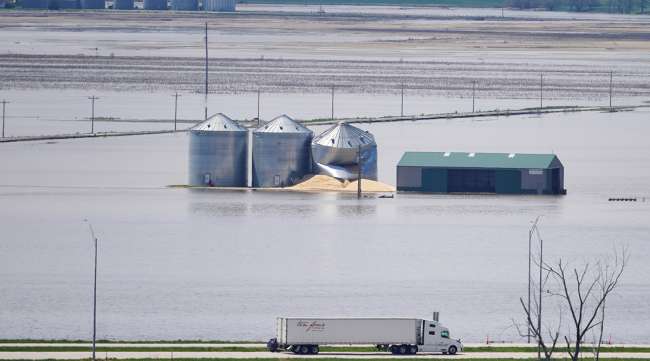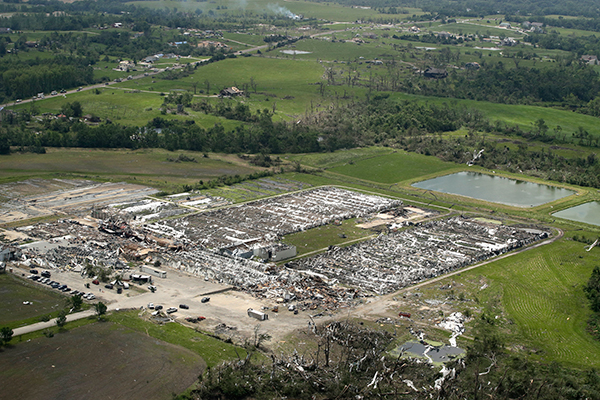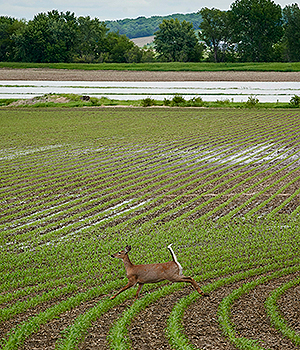Staff Reporter
Officials Monitor Damage as Floods Continue to Devastate Transportation Systems and Farms

[Stay on top of transportation news: Get TTNews in your inbox.]
Federal officials continue to monitor central states that have been rocked by severe storms, which have damaged infrastructure and saturated swaths of farmland.
The Federal Highway Administration announced May 31 that the relentless flooding that has drenched the Midwest since March has resulted in dozens of road and bridge closures across Missouri, Illinois, Iowa, Kansas, Arkansas, Oklahoma and Nebraska.
Flooding is particularly intense along the Missouri River. The National Weather Service reported that the river’s floodwaters had risen to 31.8 feet in Omaha, Neb., on June 4.
“We are working closely with our state department of transportation partners to monitor the situation and stand ready to provide any aid the agency can to assist with getting impacted roads and bridges reopen for travel as soon as it is safe to do so,” said Federal Highway Administrator Nicole Nason.
There have been 150 highway closures since mid-April in Oklahoma, which has been buffeted by heavy rains and tornadoes. As of June 4, some 15 damaged highways were still closed, according to Cody Boyd, a spokesman for the Oklahoma Department of Transportation.

A destroyed commercial greenhouse near Linwood, Kan., is viewed May 30 after an EF-4 tornado tore through the countryside May 28. (Associated Press/Charlie Riedel)
Iowa DOT spokeswoman Andrea Henry said portions of several important routes in the western part of the state, such as interstates 29 and 680, have experienced sporadic closures due to the swelling of the Missouri River.
Chad Hart, an associate professor of economics at Iowa State University, identified I-29 as an important north-south route that connects to Kansas City. Hart, who specializes in crop markets, identified the flooding as a triple threat that has affected interstate, rail and river transportation systems.
“For a lot of our crop, when you’re thinking about corn and soybean production here in the state of Iowa, a fair amount of that will move down that I-29 corridor,” Hart said. “The flooding has had a significant impact on grain flow movement throughout the countryside.”
Jon Samson, executive director of American Trucking Associations’ Agricultural and Food Transporters Conference, said that severe weather places a strain on farmers in addition to carriers. Fields are usually treated with fertilizers in March and early April before planting begins in mid-April and May. However, Samson noted that saturated ground can disrupt fertilizer application and subsequent seeding.

A deer is seen May 29 in a field which is partially flooded near Anderson, Iowa. (Associated Press/Nati Harnik)
Farms will yield less product if seeding is delayed or abandoned entirely. Samson used the example of Indiana farmers who, during a period of flooding about eight years ago, re-planted corn four times because the fertilizer and seed wouldn’t stay in the ground. After the fourth try, the farmers gave up. Samson said farmers will likely encounter similar difficulties if flooding persists over the coming months.
“Now you’re going to have significantly less product coming out of those areas due to smaller yield because the product wasn’t there long enough or [there’s] no product at all because they just couldn’t get it in the ground,” Samson said. “Those are probably going to be some concerns that people start talking about as we get further into the summertime.”
Hart noted that, on the positive side, many farms have leftover crops from last year. He explained that products can ebb and flow; if a harvest is short one year, farms will try to make up for it the subsequent year.
“In a certain sense, we’re lucky in that we do have a fair amount of crop from last year that’s still available right now, so that will help cushion the blow of the short crop this year,” Hart said. “It’s a problem of trying to line up available supplies and getting it to where it is needed.”




